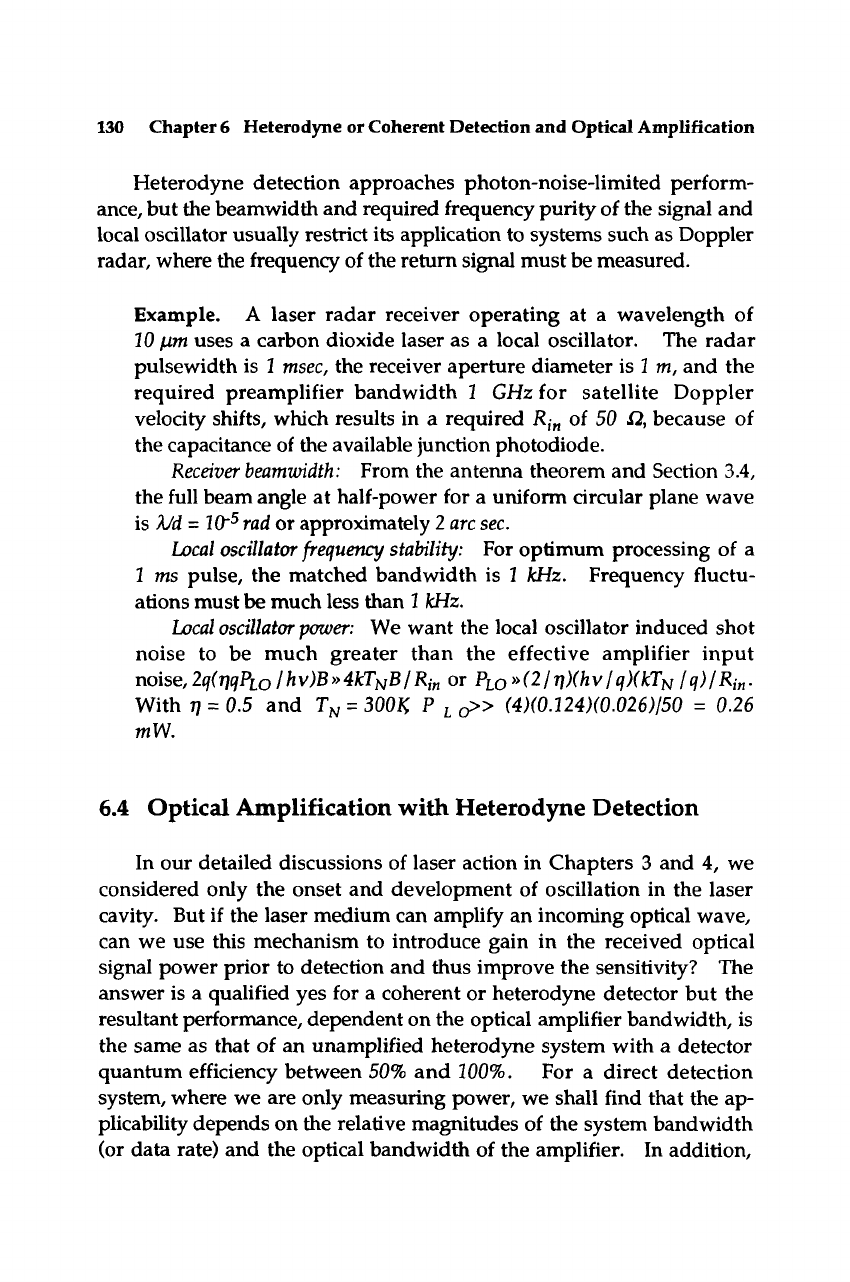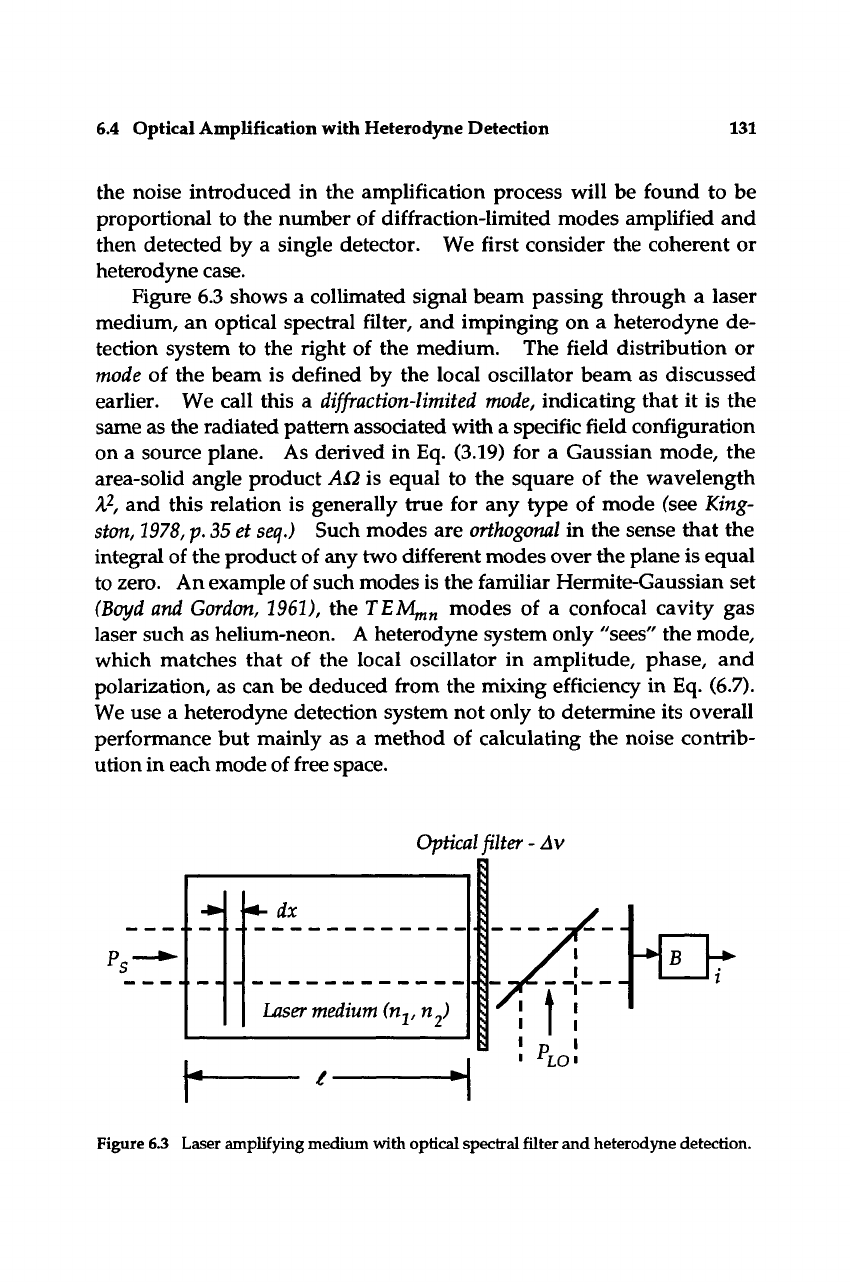
130 Chapter
6
Heterodyne or Coherent Detection and Optical Amplification
Heterodyne detection approaches photon-noise-limited perform-
ance, but the beamwidth and required frequency purity of the signal and
local oscillator usually restrict its application to systems such as Doppler
radar, where the frequency of the return signal must be measured.
Example. A laser radar receiver operating at a wavelength of
10
imi uses a carbon dioxide laser as a local oscillator. The radar
pulsewidth is 1
msec,
the receiver aperture diameter is I m, and the
required preamplifier bandwidth 1 GHz for satellite Doppler
velocity shifts, which results in a required i?,„ of 50 Q, because of
the capacitance of the available junction photodiode.
Receiver
beamzvidth:
From the antenna theorem and Section 3.4,
the full beam angle at half-power for a uniform circular plane wave
is A/d =
10"^
rad
or approximately
2 arc
sec.
Local oscillator frequency
stability:
For optimum processing of a
1 ms pulse, the matched bandwidth is I kHz. Frequency fluctu-
ations must be much less than
1
kHz.
Local oscillator
power:
We want the local oscillator induced shot
noise to be much greater than the effective amplifier input
noise,2q(rjqPioIhv)B»4kT^B/Riri or Pio»(2/7])(hv/q)(kT^/q)/Rin.
With
7]
= 0.5 and T^ = 300K P
L
o» (4)(0.U4)(0.026)/50 = 0.26
mW.
6.4 Optical Amplification with Heterodyne Detection
In our detailed discussions of laser action in Chapters 3 and 4, we
considered only the onset and development of oscillation in the laser
cavity. But if the laser medium can amplify an incoming optical wave,
can we use this mechanism to introduce gain in the received optical
signal power prior to detection and thus improve the sensitivity? The
answer is a qualified yes for a coherent or heterodyne detector but the
resultant performance, dependent on the optical amplifier bandwidth, is
the same as that of an unamplified heterodyne system with a detector
quantum efficiency between
507o
and
1007o.
For a direct detection
system, where we are only measuring power, we shall find that the ap-
plicability depends on the relative magnitudes of the system bandwidth
(or data rate) and the optical bandwidth of the amplifier. In addition.

6.4 Optical Amplification with Heterodyne Detection
131
the noise introduced in the amplification process will be found to be
proportional to the number of diffraction-limited modes amplified and
then detected by a single detector. We first consider the coherent or
heterodyne case.
Figure 6.3 shows a coUimated signal beam passing through a laser
medium, an optical spectral filter, and impinging on a heterodyne de-
tection system to the right of the medium. The field distribution or
mode of the beam is defined by the local oscillator beam as discussed
earlier. We call this a
diffraction-limited
mode,
indicating that it is the
same as the radiated pattern associated with a specific field configuration
on a source plane. As derived in Eq. (3.19) for a Gaussian mode, the
area-solid angle product AQ is equal to the square of the wavelength
X^,
and this relation is generally true for any type of mode (see King-
ston,
1978,
p.
35 et
seq.)
Such modes are
orthogonal
in the sense that the
integral of the product of any two different modes over the plane is equal
to zero. An example of such modes is the familiar Hermite-Gaussian set
(Boyd
and
Gordon,
1961), the
TEM^^^
modes of a confocal cavity gas
laser such as helium-neon. A heterodyne system only "sees" the mode,
which matches that of the local oscillator in amplitude, phase, and
polarization, as can be deduced from the mixing efficiency in Eq. (6.7).
We use a heterodyne detection system not only to determine its overall
performance but mainly as a method of calculating the noise contrib-
ution in each mode of free space.
Optical
filter
- Av
dx
Laser medium
(n^ nj
B
Figure 6.3 Laser amplifying medium with optical spectral filter and heterodyne detection.
Get Optical Sources, Detectors, and Systems now with the O’Reilly learning platform.
O’Reilly members experience books, live events, courses curated by job role, and more from O’Reilly and nearly 200 top publishers.

